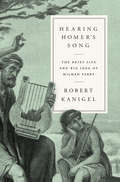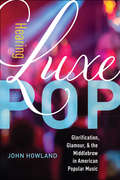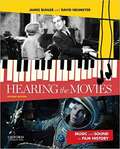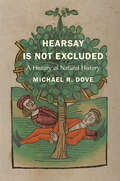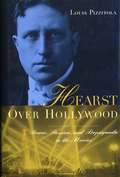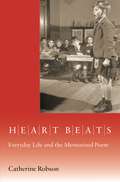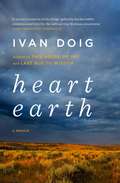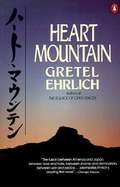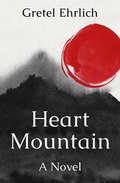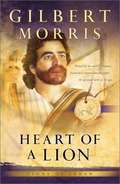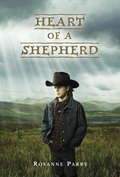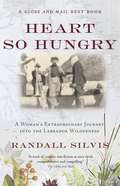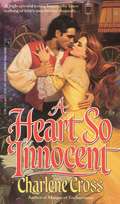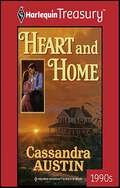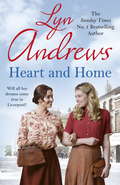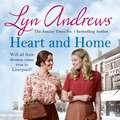- Table View
- List View
Hearing Harmony: Toward a Tonal Theory for the Rock Era
by Christopher DollHearing Harmony offers a listener-based, philosophical-psychological theory of harmonic effects for Anglophone popular music since the 1950s. It begins with chords, their functions and characteristic hierarchies, then identifies the most common and salient harmonic-progression classes, or harmonic schemas. The identification of these schemas, as well as the historical contextualization of many of them, allows for systematic exploration of the repertory’s typical harmonic transformations (such as chord substitution) and harmonic ambiguities. Doll provides readers with a novel explanation of the assorted aural qualities of chords, and how certain harmonic effects result from the interaction of various melodic, rhythmic, textural, timbral, and extra-musical contexts, and how these interactions can determine whether a chordal riff is tonally centered or tonally ambiguous, whether it sounds aggressive or playful or sad, whether it seems to evoke an earlier song using a similar series of chords, whether it sounds conventional or unfamiliar.
Hearing Homer's Song: The Brief Life and Big Idea of Milman Parry
by Robert KanigelFrom the acclaimed biographer of Jane Jacobs and Srinivasa Ramanujan comes the first full life and work of arguably the most influential classical scholar of the twentieth century, who overturned long-entrenched notions of ancient epic poetry and enlarged the very idea of literature.In this literary detective story, Robert Kanigel gives us a long overdue portrait of an Oakland druggist's son who became known as the "Darwin of Homeric studies." So thoroughly did Milman Parry change our thinking about the origins of Homer's Iliad and Odyssey that scholars today refer to a "before" Parry and an "after." Kanigel describes the "before," when centuries of readers, all the way up until Parry's trailblazing work in the 1930's, assumed that the Homeric epics were "written" texts, the way we think of most literature; and the "after" that we now live in, where we take it for granted that they are the result of a long and winding oral tradition. Parry made it his life's work to develop and prove this revolutionary theory, and Kanigel brilliantly tells his remarkable story--cut short by Parry's mysterious death by gunshot wound at the age of thirty-three.From UC Berkeley to the Sorbonne to Harvard to Yugoslavia--where he traveled to prove his idea definitively by studying its traditional singers of heroic poetry--we follow Parry on his idiosyncratic journey, observing just how his early notions blossomed into a full-fledged theory. Kanigel gives us an intimate portrait of Parry's marriage to Marian Thanhouser and their struggles as young parents in Paris, and explores the mystery surrounding Parry's tragic death at the Palms Hotel in Los Angeles. Tracing Parry's legacy to the modern day, Kanigel explores how what began as a way to understand the Homeric epics became the new field of "oral theory," which today illuminates everything from Beowulf to jazz improvisation, from the Old Testament to hip-hop.
Hearing Luxe Pop: Glorification, Glamour, and the Middlebrow in American Popular Music (California Studies in Music, Sound, and Media #2)
by John HowlandHearing Luxe Pop explores a deluxe-production aesthetic that has long thrived in American popular music, in which popular-music idioms are merged with lush string orchestrations and big-band instrumentation. John Howland presents an alternative music history that centers on shifts in timbre and sound through innovative uses of orchestration and arranging, traveling from symphonic jazz to the Great American Songbook, the teenage symphonies of Motown to the "countrypolitan" sound of Nashville, the sunshine pop of the Beach Boys to the blending of soul and funk into 1970s disco, and Jay-Z’s hip-hop-orchestra events to indie rock bands performing with the Brooklyn Philharmonic. This book attunes readers to hear the discourses gathered around the music and its associated images as it examines pop’s relations to aspirational consumer culture, theatricality, sophistication, cosmopolitanism, and glamorous lifestyles.
Hearing The Movies: Music And Sound In Film History
by James Buhler David NeumeyerHearing the Movies, Second Edition, combines a historical and chronological approach to the study of film music and sound with an emphasis on building listening skills. Through engaging, accessible analyses and exercises, the book covers all aspects of the subject, including how a soundtrack is assembled to accompany the visual content, how music enhances the form and style of key film genres, and how technology has influenced the changing landscape of film music.
Hearing Things: Religion, Illusion, and the American Enlightenment
by Leigh Eric SchmidtThis book takes us into the ensuing debate about “hearing things”―an intense, entertaining, even spectacular exchange over the auditory immediacy of popular Christian piety. The struggle was one of encyclopedic range, and Leigh Eric Schmidt conducts us through natural histories of the oracles, anatomies of the diseased ear, psychologies of the unsound mind, acoustic technologies (from speaking trumpets to talking machines), philosophical regimens for educating the senses, and rational recreations elaborated from natural magic, notably ventriloquism and speaking statues. Hearing Things enters this labyrinth―all the new disciplines and pleasures of the modern ear―to explore the fate of Christian listening during the Enlightenment and its aftermath. In Schmidt’s analysis the reimagining of hearing was instrumental in constituting religion itself as an object of study and suspicion. The mystic’s ear was hardly lost, but it was now marked deeply with imposture and illusion.
Hearing Voices: Aurality and New Spanish Sound Culture in Sor Juana Inés de la Cruz (New Hispanisms)
by Sarah FinleyHearing Voices takes a fresh look at sound in the poetry and prose of colonial Latin American poet and nun Sor Juana Inés de la Cruz (1648/51–95). A voracious autodidact, Sor Juana engaged with early modern music culture in a way that resonates deeply in her writing. Despite the privileging of harmony within Sor Juana’s work, however, links between the poet’s musical inheritance and subjects such as acoustics, cognition, writing, and visual art have remained unexplored. These lacunae have marginalized nonmusical aurality and contributed to the persistence of both ocularcentrism and a corresponding visual dominance in scholarship on Sor Juana—and indeed in early modern cultural production in general. As in many areas of her work, Sor Juana’s engagement with acoustical themes restructures gendered discourses and transposes them to a feminine key. Hearing Voices focuses on these aural conceits in highlighting the importance of sound and—in most cases—its relationship with gender in Sor Juana’s work and early modern culture. Sarah Finley explores attitudes toward women’s voices and music making; intersections of music, rhetoric, and painting; aurality in Baroque visual art; sound and ritual; and the connections between optics and acoustics. Finley demonstrates how Sor Juana’s striking aurality challenges ocularcentric interpretations and problematizes paradigms that pin vision to logos, writing, and other empirical models that traditionally favor men’s voices. Sound becomes a vehicle for women’s agency and responds to anxiety about the female voice, particularly in early modern convent culture.
Hearing, Sound, and the Auditory in Ancient Greece (Studies in Continental Thought)
by Jill GordonHearing, Sound, and the Auditory in Ancient Greece represents the first wide-ranging philosophical study of the role of sound and hearing in the ancient Greek world. Because our modern western culture is a particularly visual one, we can overlook the significance of the auditory which was so central to the Greeks. The fifteen chapters of this edited volume explore "hearing" as being philosophically significant across numerous texts and figures in ancient Greek philosophy. Through close analysis of the philosophy of such figures as Homer, Heraclitus, Pythagoreans, Sophocles, Empedocles, Socrates, Plato, Aristotle, Hearing, Sound, and Auditory in Ancient Greece presents new and unique research from philosophers and classicists that aims to redirect us to the ways in which sound, hearing, listening, voice, and even silence shaped and reflected the worldview of ancient Greece.
Hearsay Is Not Excluded: A History of Natural History (Yale Agrarian Studies Series)
by Michael R. DoveThis chronicle of natural history argues that the modern environmental crisis and rise in science skepticism codeveloped with the rise of ever narrower scientific disciplines For millennia, the field of natural history promoted a knowledgeable and unifying view of the world. In contrast, the modern rise of narrow scientific disciplines has promoted a dichotomy between nature and culture on the one hand and between scientific and folk knowledge on the other. Drawing on the fields of anthropology, history, and environmental science, Michael R. Dove argues that the loss of this historic holistic vision of the world is partly to blame for contemporary environmental degradation and science skepticism. Dove bases this thesis on a study of four pioneering natural historians across four centuries: Georg Eberhard Rumphius (seventeenth century), Carl Linnaeus (eighteenth century), Alfred Russel Wallace (nineteenth century), and Harold C. Conklin (twentieth century). Dove studies their field craft and writing; the political, cultural, and environmental circumstances in which they worked; the sources of their insight; and the implications of their work for modern society. Most of all, the book seeks to discover what enabled those natural historians to straddle boundaries that today seem impassable and to distill that wisdom for a modern world greatly in need of a holistic vision of people and environment.
Hearst Over Hollywood: Power, Passion, and Propaganda in the Movies
by Louis PizzitolaHollywood—crossroads of filmmaking, mythmaking, and politics—was dominated by one man more than any other for most of its history. It was William Randolph Hearst who understood how to use cinema to exploit the public's desire for entertainment and to create film propaganda to further his own desire for power. From the start, Hearst saw his future and the future of Hollywood as one and the same. He pioneered and capitalized on the synergistic relationship between yellow journalism and advertising and motion pictures. He sent movie cameramen to the inauguration of William McKinley and the front lines of the Spanish-American War. He played a prominent role in organizing film propaganda for both sides fighting World War I. By the 1910s, Hearst was producing his own pictures—he ran one of the first animation studios and made many popular and controversial movie serials, including The Perils of Pauline (creating both the scenario and the catchphrase title) and Patria. As a feature film producer, Hearst was responsible for some of the most talked-about movies of the 1920s and 1930s. Behind the scenes in Hollywood, Hearst had few equals—he was a much-feared power broker from the Silent Era to the Blacklisting Era. Hearst Over Hollywood draws on hundreds of previously unpublished letters and memos, FBI Freedom of Information files, and personal interviews to document the scope of Hearst's power in Hollywood. Louis Pizzitola tells the hidden story of Hearst's shaping influence on both film publicity and film censorship—getting the word out and keeping it in check—as well as the growth of the "talkies," and the studio system. He details Hearst's anti-Semitism and anti-Communism, used to retaliate for Citizen Kane and to maintain dominance in the film industry, and exposes his secret film deal with Germany on the eve of World War II. The author also presents new insights into Hearst's relationships with Marion Davies, Will Hays, Louis B. Mayer, Franklin D. Roosevelt, Mussolini, Hitler, and the Kennedys. Hearst Over Hollywood is a tour de force of biography, cultural study, and film history that reveals as never before the brilliance and darkness of Hearst's prophetic connection with Hollywood.
Hearst Over Hollywood: Power, Passion, and Propaganda in the Movies (Film and Culture Series)
by Louis PizzitolaHollywood—crossroads of filmmaking, mythmaking, and politics—was dominated by one man more than any other for most of its history. It was William Randolph Hearst who understood how to use cinema to exploit the public's desire for entertainment and to create film propaganda to further his own desire for power. From the start, Hearst saw his future and the future of Hollywood as one and the same. He pioneered and capitalized on the synergistic relationship between yellow journalism and advertising and motion pictures. He sent movie cameramen to the inauguration of William McKinley and the front lines of the Spanish-American War. He played a prominent role in organizing film propaganda for both sides fighting World War I. By the 1910s, Hearst was producing his own pictures—he ran one of the first animation studios and made many popular and controversial movie serials, including The Perils of Pauline (creating both the scenario and the catchphrase title) and Patria. As a feature film producer, Hearst was responsible for some of the most talked-about movies of the 1920s and 1930s. Behind the scenes in Hollywood, Hearst had few equals—he was a much-feared power broker from the Silent Era to the Blacklisting Era.Hearst Over Hollywood draws on hundreds of previously unpublished letters and memos, FBI Freedom of Information files, and personal interviews to document the scope of Hearst's power in Hollywood. Louis Pizzitola tells the hidden story of Hearst's shaping influence on both film publicity and film censorship—getting the word out and keeping it in check—as well as the growth of the "talkies," and the studio system. He details Hearst's anti-Semitism and anti-Communism, used to retaliate for Citizen Kane and to maintain dominance in the film industry, and exposes his secret film deal with Germany on the eve of World War II. The author also presents new insights into Hearst's relationships with Marion Davies, Will Hays, Louis B. Mayer, Franklin D. Roosevelt, Mussolini, Hitler, and the Kennedys. Hearst Over Hollywood is a tour de force of biography, cultural study, and film history that reveals as never before the brilliance and darkness of Hearst's prophetic connection with Hollywood.
Heart Beats: Everyday Life and the Memorized Poem
by Catherine RobsonMany people in Great Britain and the United States can recall elderly relatives who remembered long stretches of verse learned at school decades earlier, yet most of us were never required to recite in class. Heart Beats is the first book to examine how poetry recitation came to assume a central place in past curricular programs, and to investigate when and why the once-mandatory exercise declined. Telling the story of a lost pedagogical practice and its wide-ranging effects on two sides of the Atlantic, Catherine Robson explores how recitation altered the ordinary people who committed poems to heart, and changed the worlds in which they lived. Heart Beats begins by investigating recitation's progress within British and American public educational systems over the course of the nineteenth and twentieth centuries, and weighs the factors that influenced which poems were most frequently assigned. Robson then scrutinizes the recitational fortunes of three short works that were once classroom classics: Felicia Hemans's "Casabianca," Thomas Gray's "Elegy Written in a Country Churchyard," and Charles Wolfe's "Burial of Sir John Moore after Corunna." To conclude, the book considers W. E. Henley's "Invictus" and Rudyard Kipling's "If--," asking why the idea of the memorized poem arouses such different responses in the United States and Great Britain today. Focusing on vital connections between poems, individuals, and their communities, Heart Beats is an important study of the history and power of memorized poetry.
Heart Earth: A Memoir
by Ivan DoigIvan Doig’s companion memoir to his bestselling This House of Sky—inspired by the letters his mother wrote during World War II—is “a lyrical evocation of the Doigs’ gallantly hardscrabble existence and love for the unforgiving Montana mountains” (San Francisco Chronicle).Raised by his father and maternal grandmother, Ivan Doig grew up with only a vague memory of his mother, who died on his sixth birthday. Then he discovered a cache of her letters, and through them, a spunky, passionate, can-do woman emerged. His mother was as at home in the saddle as behind a sewing machine, and as in love with language as her son. In this prize-winning prequel to his acclaimed memoir This House of Sky, Doig brings to life his childhood before his mother’s death, and the family’s journey from the Montana mountains to the Arizona desert and back again. “Profoundly original and lustrous,” (Kirkus Reviews) Doig eloquently captures the texture of the American West during and after World War II, the fortune of a family, and one woman’s indomitable spirit. Doig is “a colloquial stylist without equal…and Heart Earth is a book that repeatedly proves the power of language” (Los Angeles Times).
Heart Land: A Novel
by Kimberly StuartA story of reconnection, lost love, and the power of faith, Heart Land follows a struggling fashion designer back to her small Iowa hometown as she tries to follow her dreams of success and finding true love.Grace Klaren has finally made her dream of living in the Big Apple and working in the fashion industry a reality. But when she’s unexpectedly fired and can’t afford the next month’s rent, Grace does something she never thought she’d do: she moves back home. Back in Silver Creek, Iowa, Grace is determined to hate it. She rails against the quiet of her small town, where everything closes early, where there’s no nightlife, where everyone knows each other. She’s saving her pennies and plotting her return to New York when she almost runs over a man who’s not paying attention at a crosswalk. It turns out to be Tucker, her high school sweetheart whose heart she broke when she left ten years ago. They reconnect, and Grace remembers why she fell for him in the first place. And her career begins to turn around when she finds a gorgeous but tattered vintage dress at a flea market. She buys it, rips it apart seam by seam, and re-creates it with new fabric, updating the look with some of her own design ideas. She snaps a picture and lists the dress online, and within a day, it sells for nearly $200. Suddenly, Grace has her ticket out of here. But Grace can’t fight her growing feelings for Tucker. Sometimes when they’re together, Tucker paints a picture of what their future could be like, and it feels so real. And when she finally gains the funding to move her new business back to New York, Grace must decide where home really is—will she chase her long-held New York dream, or find a new dream here in the heartland?
Heart Mountain
by Gretel EhrlichEhrlich explores the twin solitudes of political exile and geographic isolation in this powerful novel -- the story of Japanese Americans forced into a relocation camp -- set in Wyoming during World War II.
Heart Mountain: A Novel
by Gretel EhrlichA &“dazzling first novel&” about Japanese Americans and their Wyoming neighbors in the era of WWII internment camps (Chicago Tribune). A renowned chronicler of life in the West, Gretel Ehrlich turns her talents to a moment in history when American citizens were set against each other, offering &“a novel full of immense poetic feeling for the internal lives of its varied characters and the sublime high plains landscape that is its backdrop&” (The New York Times Book Review). This is the story of Kai, a graduate student reunited with his old-fashioned parents in the most painful way possible; Mariko, a gifted artist; Mariko&’s husband, a political dissident; and her aging grandfather, a Noh mask carver from Kyoto. It is also the story of McKay, who runs his family farm outside the nearby town; Pinkey, an alcoholic cowboy; and Madeleine, whose soldier husband is missing in the Pacific. Most of all, Heart Mountain is about what happens when these two groups collide. Politics, loyalty, history, love—soon the bedrocks of society will seem as transient and fleeting as life itself. Set at the real-life Heart Mountain Relocation Center in Wyoming, this powerful novel paints &“a sweeping, yet finely shaded portrait of a real West unfolding in historical time&” (The Christian Science Monitor).
Heart Of A Lion (Lions Of Judah, Book #1)
by Gilbert MorrisYoung Noah has found life good and wholesome ... until he steps outside his village and discovers a world of temptation. Drawn by a beautiful woman yet repulsed by the pagan practices of her tribe's dark worship, his inner struggle keeps him in torment. Noah strains to hear the voice of God-through the warnings of a prophet, through the kind teachings of his grandfather Methuselah, through the loving concern of his family, and ultimately through personal confrontation. The message he receives is terrifying. Will he find the courage to obey? Opposition intensifies to the call he has received, and a precious medallion handed down from ancient times reminds him of who he is ... a man with a HEART OF A LION.
Heart Of A Shepherd
by Rosanne ParryWhen Brother's dad is shipped off to Iraq, along with the rest of his reserve unit, Brother must help his grandparents keep the ranch going. He’s determined to maintain it just as his father left it, in the hope that doing so will ensure his father’s safe return. The hardships Brother faces will not only change the ranch, but also reveal his true calling. From the Hardcover edition.
Heart Rhythm Disorders: History, Mechanisms, and Management Perspectives
by J. Anthony GomesThis engaging book covers a multitude of topics related to heart rhythm disorders (HRDs) and uniquely familiarizes readers with the development of treatment modalities over the past several decades, including the evolution of anti-arrhythmic drugs, pacemakers, defibrillators, and catheter ablation. Organized in ten sections, this title serves as both an archival and a contemporary resource for clinicians. The first section describes the discovery of the circulatory system by William Harvey in 1628 and outlines the development and understanding of HRD since the advent of intra-cardiac electrophysiology. Subsequent sections discuss the historical evolution of abnormal heart rhythms, such as supra and ventricular rhythms and sudden cardiac death, their treatment with drugs, surgery, pacemakers, implantable defibrillators and catheter ablation. Section nine offers a fascinating narration of the clinical evolution of overcoming heart attacks and its impact on HRDs. The final section explores potential new frontiers in HRD and the factors that may contribute to the prospective rise of cardiovascular diseases. A ground-breaking and invaluable addition to the clinical literature, Heart Rhythm Disorders: History, Mechanisms and Management Perspectives details the pervasive nature of cardiovascular diseases in human history, their ramifications, and their projected effects on at-risk demographic populations and human health in general.
Heart So Hungry: A Woman's Extraordinary Journey into the Labrador Wilderness
by Randall SilvisA gripping cold weather, true-life adventure, Heart So Hungry tells the story of a race across Labrador and one woman's determination -- inspired by grief and fed by outrage -- to set the record straight. A remarkable adventure, a love story and a thrilling race are all front and centre in this account of how one woman's devotion to her late husband's memory transformed Mina Hubbard from a rural Ontario nurse into the most celebrated female explorer of her time. In 1903, following an ambitious expedition to map the interior of Labrador, Mina's husband, Leonidas, dies of starvation in a cold, boggy, wind-scoured landscape. Allegations surface that the expedition failed because of Hubbard's incompetence, so Dillon Wallace, Leonidas' partner on the failed expedition, decides to honour a promise that he made to Hubbard to complete the route that they had been supposed to take. When Mina Hubbard discovers what Wallace has planned, she doubts his motives and decides to mount her own Labrador expedition and to beat Wallace to the finish line. Driven by her devotion, Mina wins the race, beating Wallace by a month and a half, and becomes in the process the first white woman to make contact with the elusive Naskapis Indians. Using original, unpublished source material, as well as books written by the main actors in the drama, novelist Randall Silvis pieces together a narrative of the race between Wallace and Mina Hubbard, as well as the fateful first expedition of Wallace and Leonidas Hubbard.
Heart So Innocent
by Charlene CrossQueen Victoria herself had decreed it: Lady Aidan Prescott must marry. The girl was too wild -- a husband would settle her. But Aidan would never accept her irate father's choice, a wealthy older man who had already buried two wives. She fled London, placing her life in the hands of the arrogantly handsome young Duke of Westover, Justin Warfield, who was to escort her to a Scottish estate where a younger, more compliant bridegroom awaited. Warfield was fascinated by the copper-haired beauty ... torn between a surging desire for his naive, rebellious charge and the dark legacy which kept him from giving his heart to any woman. The sparks of fate ignited when Aidan's father forced them to marry. Furious, each vowed to live separate lives, refusing to yield to the desire that so urgently flamed between them. But not even the force of their combined wills could quench the inferno that raged in their souls...
Heart Specialist
by Claire Holden RothmanAn incredible story of perseverance and passion, The Heart Specialist sets the young, headstrong Agnes White against the prejudice and arrogance of the medical establishment in a battle that will eventually grant her the right to save lives as a practising doctor. Set against the upheaval and social strictures of the early 1900s and based on true events, this unforgettable novel is a testament to the spirit, intelligence, and determination we summon when people stand in the way of our dreams.
Heart and Home
by Cassandra AustinMen Were Just Plain Inconvenient!Jane Sparks had a business to run, and no citified doctor filled with Wild West fantasies was going to distract her. Even one as warm and handsome as Dr. Adam Hart, the only man who ever tempted her into nightly dreams of love...!Women Were A Complete Mystery....Miss Sparks was aptly named. The busy brunette had certainly sparked Adam Hart's interest! He'd never known a woman so capable, caring and fresh-faced beautiful in his life. And, her happy mothering of a lonely little girl made her just what the doctor ordered....
Heart and Home: Will all their dreams come true?
by Lyn AndrewsAs a shop girl in a big department store in 1930s Liverpool, Cathie enjoys every day with her many friends and customers. Love beckons too - but have her sweet face and warm personality attracted a cad? Heart and Home is a poignant saga of shop girls in 1930s Liverpool from bestselling author, Lyn Andrews. Perfect for fans of Anne Baker, Dilly Court and Kate Thompson.Cathie Kinrade is all too used to hardship. Growing up on the Isle of Man in the 1930s, she sees her da set sail daily on dangerous seas while her mam struggles to put food on the table. Cathie has little hope for her own future, until a chance encounter changes her fortunes for ever.Fiercely determined, Cathie leaves for Liverpool, a bustling modern city full of possibility. With a lively job as a shop girl in a grand department store, and a firm friend in kind-hearted Julia, Cathie has found her niche. But the discovery of an explosive secret could put everything at risk. And when love comes calling, Cathie's new friends fear that she may be set to trust the wrong man with her heart... What readers are saying about Heart and Home: 'Heart and Home is an excellent read for when you want to sit back and relax... a touch of light, romantic, family and friend based escapism''Lyn Andrews always writes such vivid stories of Liverpool in the 1930s and the strong female characters that populate the streets of that lovely city... A great, heart-warming story''Great read! Loved the storyline and characters - read in one night as I couldn't put this down'
Heart and Home: Will all their dreams come true?
by Lyn AndrewsHEART AND HOME is a poignant saga of shop girls in 1930s Liverpool from Lyn Andrews, the Sunday Times bestselling author of FROM LIVERPOOL WITH LOVE and THE HOUSE ON LONELY STREET. Not to be missed by readers of Dilly Court and Katie Flynn.Cathie Kinrade is all too used to hardship. Growing up on the Isle of Man in the 1930s, she sees her da set sail daily on dangerous seas while her mam struggles to put food on the table. Cathie has little hope for her own future, until a chance encounter changes her fortunes for ever. Fiercely determined, Cathie leaves for Liverpool, a bustling modern city full of possibility. With a lively job as a shop girl in a grand department store, and a firm friend in kind-hearted Julia, Cathie has found her niche. But the discovery of an explosive secret could put everything at risk. And when love comes calling, Cathie's new friends fear that she may be set to trust the wrong man with her heart...(P)2015 Headline Digital
Heart and Science: A Story of the Present Time (Classics To Go)
by Wilkie Collins“Heart and Science”, one of Wilkie Collins' later novels, is concerned with the debate over what he termed 'the hideous secrets of vivisection.' The tale of a family split by various opinions and sentiments, as well as the novel's clear parallels to the animal welfare/animal rights debates of today will strike chords of understanding with modern readers, who always relate well to the accessible conversational style of Collins' prose. (Excerpt from Goodreads)

